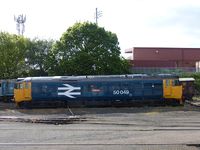BR Class 50 50049 Defiance
BRBritish Rail or British Railways Class 50
Fifty English Electric Type 4The British Railways classification for diesel locomotives of 2000 bhp to 2999 bhp (later BRBritish Rail or British Railways Class 50) diesel locomotives were built by English Electric at their Vulcan Foundry Works plant in Newton-le-Willows between 1967 and 1968. When built they were numbered in the D4xx series. They later became BRBritish Rail or British Railways’s Class 50, being allocated TOPSTotal Operations Processing System, an American computer system adopted by BR from the late 1960s to number and manage rolling stock. numbers in the 50xxx series. The class was nicknamed “Hoovers” because of the distinctive sound of the inertial air-filters with which the locomotives were originally fitted.
Initially the locomotives were used to haul express passenger trains on the West Coast Main Line (WCML) between Crewe and Scotland; that section not then being electrified. This often entailed ‘Multiple Working’, with two locomotives under control of a single driver.
By 1974 the northern WCML had been electrified, and the Class 50 fleet was being transferred to BRBritish Rail or British Railways’s Western Region to work main line passenger services out of London Paddington.
The Class 50’s did not originally carry names, but in the late 1970s BRBritish Rail or British Railways agreed to their being named after Royal Navy vessels with notable records in the First and Second World Wars.
Withdrawal of the class began in the early 1990s.
50049 Defiance in Service
D449 entered service at Stoke in December 1968. Renumbered to 50049 in January 1973, the locomotive moved to Bristol in May 1974.
In May 1978, 50049 was named Defiance after the Royal Navy's torpedo school.
In 1987, 50049 was involved in an experiment to use Class 50 locomotives on freight trains. To that end it was re-numbered as 50149, equipped with modified Class 37 lower-geared bogies, and out-shopped in trainload grey livery with Railfreight decals. Based at Plymouth Laira, two years was spent working china clay trains in Cornwall and heavy stone trains from Devon quarries to London. By 1979 the locomotive has reverted to 50049, being withdrawn from service by BRBritish Rail or British Railways in August 1991.
50049 Defiance in Preservation
50049 was bought for preservation by Project Defiance. Following an overhaul at AWSAutomatic Warning System, a form of limited cab signalling introduced in 1956 in Cardiff, it moved to the West Somerset Railway where it was repainted into the Railfreight Distribution two tone grey livery as 50149. Defiance left the WSR to attend the SVRSevern Valley Railway Diesel Gala in 1999, and remained at the SVRSevern Valley Railway thereafter. A year later, in BRBritish Rail or British Railways Blue livery as D449, it participated in its first mainline with 50031 Hood (as D431) on the Celtic Hoover Railtour in September 2000.
Project Defiance has now merged with The 50 Fund, owners of two other Class 50s and operators of a third, to form The Class 50 Alliance
Links
Class 50 Alliance web site
50 Fund web site (still maintained)
